In our new podcast series, we will be talking to doctors from The Eye Institute to get an inside look at what goes on behind the scenes and what a typical day in the life is like for a doctor at the clinic. In this episode, we met with Alissa Coyne, OD ‘10, FAAO, Resident ‘11, staff optometrist: primary care and emergency service at The Eye Institute.
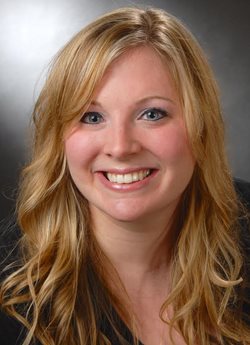 Dr. Coyne:
Dr. Coyne:
Hi, everyone. My name is Alissa Coyne. I am one of our faculty preceptors at The Eye Institute. I'm originally from outside the Scranton area from a little town called Peckville. I went to the Pennsylvania State University, where I graduated with a degree in Biobehavioral Health. I then went to PCO. It was the only optometry school that I applied to. I figured that I would keep true to my Pennsylvania roots. Then I completed a residency at The Eye Institute after graduation, and then I stayed on. I liked it so much, I couldn't really imagine leaving.
I've been providing care from a student or resident to a faculty member since 2006 in the Philadelphia area. At The Eye Institute I have a couple of different roles, which seems to be the general theme for most of our faculty members. Probably my favorite role is serving as the attending physician in our Emergency Service. In that what we do is we have a walk-in Emergency Service. The patients are triaged, where we ask them questions and determine if they need to be seen that day. Then we end up bringing them back, we examine them. We end up addressing their issues. In that role, I end up working with both the resident who is in Emergency at that time, and then also our students are usually third or fourth year students and working through the cases.
I also work in our Scholars Clinic, which our Scholars Program is a three-year program. I end up seeing patients in a primary care setting where we manage all aspects, whether it ends up being ocular manifestations of systemic disease, they end up having glaucoma, and I end up seeing patients also in that role.
I also serve as another aspect with Residency Support. We have an excellent Residency Program that is 54 weeks. We have usually about 12 in-house residents that you'll see milling around The Eye Institute. When we first start at the clinic in July, it takes a little bit of time for us to get them on different insurance panels that they can see and sign off on patients by themselves, but not only that, they have a growth period where there's somebody that's there to help support them in their decision-making process and work with them through different differential diagnoses and treatment and management plans. That's usually what I do on Monday mornings. Then I'm in our Emergency Service Monday afternoons. Then I'm in our Scholars Program Tuesday mornings and Thursday afternoons.
Hope Daluisio:
Sounds like you keep busy for sure.
Dr. Coyne:
Keep busy. That also is definitely a theme that ends up happening. When we're at The Eye Institute, I usually say, "Put your roller skates on."
Hope Daluisio:
It seems like you are busy and days are usually pretty different, but do you think you can walk us through what maybe a typical day for you would be like?

Dr. Coyne:
That's an excellent segue when you say my days are different. I think that that's probably one of my favorite parts about the job, that no two patients are going to be the same. It's also one of the reasons why I really like being in our Emergency Service is you don't know what's going to be the next thing in your chair. I like to be challenged, so you always have to be thinking about different diagnoses, what it could be, how you're going to rule that out, how you're going to end up treating the patient.
Usually a typical day, we work in sessions and a session as a four-hour period. Again, depending on where you’re staffed then determines what you're going to be doing. I’ll give you a little bit of a background about our Emergency Service. With that, sometimes it's very busy and patients unfortunately end up having to wait a little bit until we can clear a room and get them in to see them almost like you would expect in the Emergency Department of a hospital.
If I ended up seeing primary care patients, the patients get checked in at the front desk. Because of COVID, they also end up having to go through the screening and the temperature screening. We're trying to keep everybody safe, including our patients, our faculty, and our students and our staff.
We end up bringing them back. Our students are terrific and they usually will start the exam where we go through, ask them a history, "What seems to bring you in today? Having any ocular complaints?" We will also do a systemic history review. That is something I'm going to talk a little bit about is the importance of realizing just how much we can detect from a systemic level, just by looking at the eyes.
We also review medications and the student will go through and do different entrance testing. Sometimes they'll end up checking you for a glasses prescription. Then they look at the front surface of the eye or the anterior segment. This is usually when they come in to report to the doctors and the doctors will come in and repeat some of the testing. We'll ask for their history questions. It's not unusual that we end up dilating our patient's pupils to open up the pupils a little bit larger, so that we have a bigger window to the back of the eye, so that we can use lights and lenses to assess the back health.
This morning I ended up seeing four or five patients. Everybody had something a little bit different. I ended up seeing a ten-year-old. I also saw a 75-year-old. We end up seeing a huge range in patients, as far as age and their different concerns. This afternoon, I'm actually speaking with you, I'm going to end up recording a lecture, I'm going to write an exam and then I'm back to clinic for the evening. It's always a little bit different, but I think that that's what ends up keeping us on our toes. It keeps us really thinking all the time that there's no real way to settle in and get used to it and that it's going to be the same patient over and over.
Hope Daluisio:
Is there something that you do as a TEI doctor that patients, or maybe outsiders, or staff might not know?
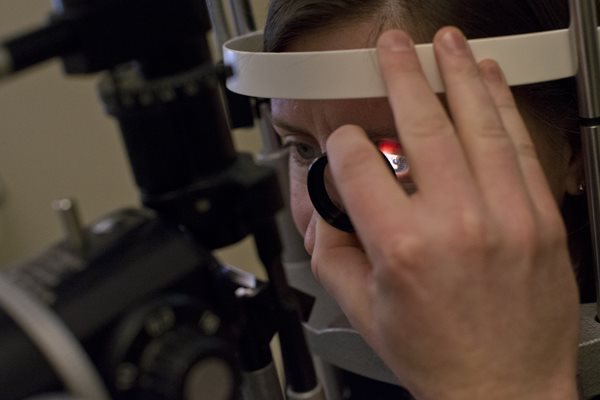
Dr. Coyne:
I think the biggest thing, especially from a patient standpoint, is to be aware of just how much we can tell about what's happening systemically or in the rest of the body, just from the eyes. Different things that can affect the eye ends up being diabetes, high blood pressure, high cholesterol. You can also see sometimes inflammatory conditions and or help diagnose systemic inflammatory conditions like rheumatoid arthritis, Crohn's disease, lupus, just to name a few.
A lot of times patients will come in expecting that they just want to have their eyes examined and we go through and we start asking them about their systemic medications, or we end up asking them about their systemic history. They're puzzled as to why we want to know all of this. It really is one of the ways that you'll hear over and over people will say, "Oh, like the eyes are the gateway to the soul," or "The eyes are the gateway to the rest of the body."
That is especially in the back of the eye, it's really the only place that you can look directly at blood vessels. What's happening with those blood vessels ends up reflecting what's happening in the rest of the body, so it's not unusual that sometimes the eye doctor is the first one seeing changes in the back of the eye associated with diabetes. That we're then either ordering blood work or recommending that they have blood work by their primary care doctor.
It's not unusual that our doctors will order blood work. Sometimes they'll order other diagnostic testing that looks at blood flow, so we can end up ordering carotid studies. As the blood flows up from the heart to the brain, to the eyes, that might be something that we're also assessing based on different ocular findings. We end up having a terrific neuro-ophthalmic disease service that a lot of times they'll order different testing, like an MRI or a CT scan, if we end up seeing different changes in the eye that could be associated with changes in the brain. When I say patients are coming in for their eye exam, yes, we're just looking at the eyes, but we can tell a whole lot by what's happening with that.
The other thing is, I touched a little bit upon it, I'm actually going for a master's degree in Pharmacology and Toxicology from Michigan State. That's in all my free time, but with that, we always kind of go through and review medication. We can sometimes pull them through our EHR program or the patients will provide us with their list.
But when I end up looking at a patient's medication list, I'm specifically going through and looking to see if any of them can possibly have ocular side effects because a patient might come in complaining about dry eye. Could it be a side effect of one of their medications? The same thing that sometimes they might have visual disturbances, whether it means flashes of light or photopsias or different things that are certain complaints that could be masked with side effects and medication.
It's also interesting just to think about how much the doctors are thinking through just in a quick review of medications to really see, are they related to any of the complaints that the patient presents with? Other times it could just be that we have to follow them appropriately. That studies have shown us that in specific medications, there can be ocular side effects that can affect vision, that we're monitoring them yearly with different testing to make sure that there's not development of things like what we call maculopathy or optic neuropathy in that situation. It's also something that I want to put out there for the patients to realize that it's important for them to realize that we are reviewing their medications for a decent amount of reasons. One of them also being that they can experience an ocular side effects, but it's one of those, we know all about heart medications. We know about diabetes medications. We know about cholesterol medications, just because of the different side effects that can be reported associated with them.
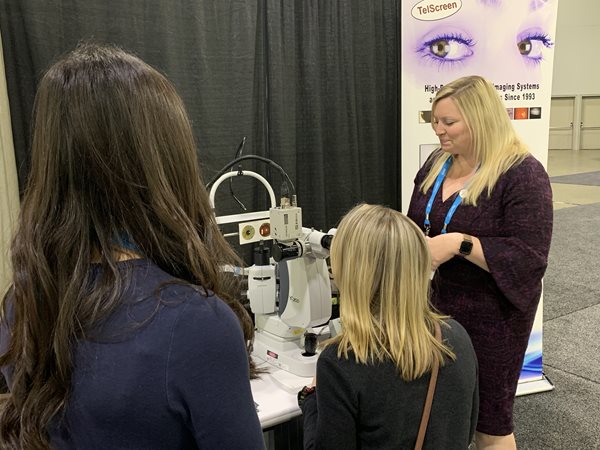
Hope Daluisio:
That's awesome that you're going for your master's. How long have you been going for that?
Dr. Coyne:
Oh, it's been a hot minute. I started in the fall of 2018. I usually take somewhere between three to four credits a semester and it's just because having a full-time job and also going back to school doesn't offer a lot of free time. I probably spend maybe 20-30 hours per week working on that. I can tell you the light is at the end of the tunnel. I am done with at the end of the semester, 22 of 31 credits. My planned completion of the program is May of 2022.
I really chose classes that I thought would help to benefit me as a provider. Then myself, also as a lecturer, I lecture for our students in ocular pharmacology. When I was looking and choosing classes, I specifically chose things like endocrine drugs, which would be for, especially our diabetes patients, or cardiac drugs for those that end up having cardiovascular disease. Another one I ended up taking was all on antibacterials. When I was choosing my courses, I ended up doing it with our students in mind and also with our patients in mind.
Hope Daluisio:
That sounds like a perfect integration of all the stuff that you balance.
Dr. Coyne:
I really enjoy it. I also think that it helps me be empathetic towards students. Again, to be in that position. I think once you get away from being a student, and I was almost a decade away from being in the classroom, but going back into it, I was like, "Oh, this is what it feels like to not know the answer and not be able to get things very easily or have that new content to deliver to you." I feel as though it's made me a better instructor in that I will try and repeat myself or trying to explain myself in a couple of different ways. Just because we have different types of learners who might end up getting it through a different explanation from what's typically provided.
Hope Daluisio:
Yeah, that's incredible. Especially now during all these times where mostly learning is online. I feel like that's definitely very beneficial for the students.
Dr. Coyne:
That's another way I also felt that it helped to improve was because my entire curriculum through Michigan State ends up being online. I ended up being able to utilize some of the suggestions or some of the different teaching tools that I had previously used and incorporate that into my lectures as we ended up having to move everything online as of March of 2020 in order to deal with COVID.
Hope Daluisio:
What is the most rewarding part of being a doctor at The Eye Institute?
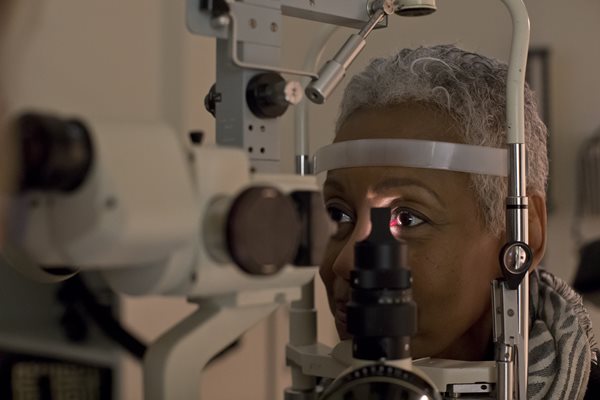
Dr. Coyne:
I have a couple of different aspects. The first is I really like interacting with our patients. They're very interesting. They have great life stories. They are so good to our students and really give them the opportunity to learn as optometric physicians and really advance their skills.
I sometimes will ask where they're originally from. We ended up having a decent amount of patients from Jamaica and Haiti, and just hearing how they ended up getting here. We also have had patients that have come here since The Eye Institute opened in the '70s. Just hearing them say, "Oh, I remember when you guys were upstairs and now you're downstairs." There's a couple of times I've flipped through old hard charts and I will end up seeing a patient now as a doctor that I saw as a student. It's really great to have that longevity associated with it.
As far as being a doctor, I really like seeing when my patients get better, especially when I'm staff in the Emergency Service that you end up diagnosing them, you end up writing for a prescription, whether that's an eye drop or an oral medication to help address their issue, you end up following them back and they're either on the mend and/or that it's resolved. It's always a little thumbs up. You did the right thing.
I always like to say, "What's going to help the patient feel better sooner?" That's really what I aim for. In order to see that success and that the management worked, that's always something that makes me happy. I think it's also exciting for the residents and for the students to see just the resolution associated with that. Then bringing together all the different aspects of their optometric career from a didactic standpoint, from being in the classroom, where they ended up learning about signs and symptoms. They learn the background. They then end up learning what you're looking for and how to do the skill to assess the front surface of the eye in Clinical Skills Lab, taking that to the clinic, seeing a patient, being able to put it all together. Then initiate that correct treatment and management. Then seeing the resolution, it puts all the pieces together, even starting from their first year through their third or fourth year.
The other thing is that I really like seeing our students grow. I have the opportunity to work a lot with our second years, a little bit with our first years, but just to see their thought process change over time, where we really got them to think like a doctor and what they're going to do to help manage this patient. What do they want to do as far as addressing the complaints of the patient? Really pushing them in that direction is probably the best part of my job, to really see that growth and helping to shape the future of our profession.
We end up graduating really great doctors. To be part of that it just really great and exciting, and it's fun. It just gives me a sense of accomplishment and to really enjoy your job. I think that that's probably the best thing to get out of life.
Hope Daluisio:
I've been lucky enough to be able to go and film some students from The Eye Institute who are working their shifts. Everything they know blows my mind. They're only like second years or third years and they could tell me any room, what happens there.
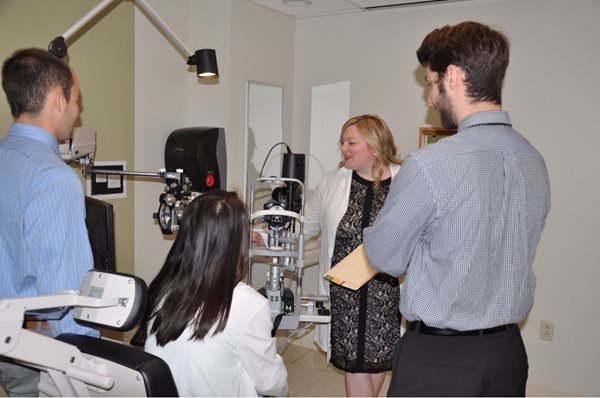
Dr. Coyne:
They're usually pretty quick on that uptake. We will sometimes have to do what we call flipped learning environment that they hadn't had it in the classroom yet. That is because when our students start clinic, they get whoever they get. We don't walk them into the shallow end and give them someone who just has a refractive error. The patients are going to end up having glaucoma. They have cataracts. They end up having other systemic issues and we throw them into the deep end and it's sink or swim. We will always make sure that they swim no matter what. We will always make sure that they swim, but it's that little bit of a shock that it wears off over time that they're ready to go. Nothing really surprises them.
Our patient population, we are so fortunate that they come to see us because they allow our students to really expand their knowledge base, especially from an ocular disease standpoint because of the different hereditary findings that we have. Not only that we end up having different specialty services that our students can be stacked in like glaucoma, like neuro, like pediatrics, like low vision/vision rehabilitation, that we ended up offering so many different specialty services that really are a benefit for our patient and our students get to observe and/or see patients within those specialty clinics. That it just really helps to grow them as a complete future optometrist.
Hope Daluisio:
Is there anything else you'd like to add about anything?
Dr. Coyne:
The first thing is, I always just want to give a shout out to the other providers. We have excellent faculty members and excellent optometrists that provide quality care at The Eye Institute. We will take great care. I think because we are a teaching institute, it allows us to take the time to explain what's happening to both the student, but also the patient.
It ends up being a learning environment for everybody. Not only that, like I said, we end up having terrific specialty clinics that if we need to send you to someone for continuity of care, so that you see the same doctor over and over, we can always offer that service when needed.
I'm always impressed with the quality of care that ends up coming out of The Eye Institute. It's not unusual that faculty members end up going to conferences and doing presentations and lectures or presenting on posters on interesting cases. Just to see the thought process or the research or the different nuanced treatment and management that ends up occurring is always very impressive. Even at a national or international level coming out of the Pennsylvania College of Optometry, coming out of The Eye Institute.
The other thing is just as a cute little note to our patients, when you come in, take your meds that day. Make sure that you're taking the medications. I'll have patients, they'll say, "Well, I knew I was going to see you, so I didn't take my drops." It's like, "No. No. Always make sure you're taking your meds," in that situation and then follow-up if we say we want to see you back in three months. We just want to check on you and make sure that everything is going well.
Overall, I always want to say that our patients are so terrific to both the doctors and the students. We're really fortunate that they continue to come to us year in and year out. New patients, because we are a teaching institute, your eye exam might be a little bit longer than what you're used to, but I promise you that you will be getting thorough care top to bottom, no stone left unturned because we are, one, doing it in the best interest of your ocular health and your systemic health, but also in order for us to help teach our students.
To learn more about The Eye Institute, you can visit SalusUhealth.com/TEI. Stay tuned for our next episode, where we'll go behind the scenes with Jeffrey Nyman, OD, FAAO, director of Emergency Services at TEI.